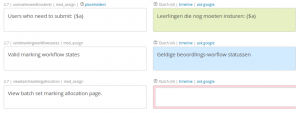Contributing a translation: Difference between revisions
From MoodleDocs
(suggest to make the contributions not to large in one go.) |
Helen Foster (talk | contribs) (info update) |
||
| Line 2: | Line 2: | ||
The [http://lang.moodle.org Translation site] enables translators to work collaboratively on language packs using a special Moodle translation tool called ''AMOS''. If you see an error or non-translated term in Moodle in your language, you can contribute a correction or translation via the Translation site. | The [http://lang.moodle.org Translation site] enables translators to work collaboratively on language packs using a special Moodle translation tool called ''AMOS''. If you see an error or non-translated term in Moodle in your language, you can contribute a correction or translation via the Translation site. | ||
==Using AMOS== | ==Using the AMOS translator== | ||
# [http://lang.moodle.org/login/signup.php Create an account on the Translation site] and log in. | # [http://lang.moodle.org/login/signup.php Create an account on the Translation site] and log in. | ||
# Click the link | # Click the link [http://lang.moodle.org/local/amos/view.php AMOS translator]. | ||
# In the Languages box, | # In the Languages box, make sure your language is selected. | ||
# | # In the Components box, find the language strings you wish to translate. | ||
# Click the button 'Save filter settings'. | # Click the button 'Save filter settings'. | ||
# Type your translation into the boxes on the right. When you click out of the box, it will turn blue and your text will be saved automatically. | # Type your translation into the boxes on the right. When you click out of the box, it will turn blue and your text will be saved automatically. | ||
# When you have finished translating, | # When you have finished translating, click the button at the bottom of the page 'Go to the stage'. Do about 30 strings at a time. | ||
# Review your translation, | # Review your translation, then click the button 'Send strings to language pack maintainers'. | ||
{| | {| | ||
|[[File:translate1.png|thumb|Add your translation]] | |[[File:translate1.png|thumb|Add your translation]] | ||
| Line 22: | Line 22: | ||
The maintainer(s) of the language pack will receive notification of your contribution. It will be reviewed and then most likely added to the language pack. The reviewing is easier if the number of strings in one contribution is not too high. | The maintainer(s) of the language pack will receive notification of your contribution. It will be reviewed and then most likely added to the language pack. The reviewing is easier if the number of strings in one contribution is not too high. | ||
Your name will appear on the | Your name will appear on the [http://lang.moodle.org Translation site] front page as a recent, valued contributor. Well done! | ||
==See also== | ==See also== | ||
* [http://www.youtube.com/watch?v=XClUZOuFfWo| Video on how to contribute to a language pack] | * [http://www.youtube.com/watch?v=XClUZOuFfWo| Video on how to contribute to a language pack] | ||
Revision as of 10:48, 28 July 2014
The Translation site enables translators to work collaboratively on language packs using a special Moodle translation tool called AMOS. If you see an error or non-translated term in Moodle in your language, you can contribute a correction or translation via the Translation site.
Using the AMOS translator
- Create an account on the Translation site and log in.
- Click the link AMOS translator.
- In the Languages box, make sure your language is selected.
- In the Components box, find the language strings you wish to translate.
- Click the button 'Save filter settings'.
- Type your translation into the boxes on the right. When you click out of the box, it will turn blue and your text will be saved automatically.
- When you have finished translating, click the button at the bottom of the page 'Go to the stage'. Do about 30 strings at a time.
- Review your translation, then click the button 'Send strings to language pack maintainers'.
What happens next
The maintainer(s) of the language pack will receive notification of your contribution. It will be reviewed and then most likely added to the language pack. The reviewing is easier if the number of strings in one contribution is not too high.
Your name will appear on the Translation site front page as a recent, valued contributor. Well done!

